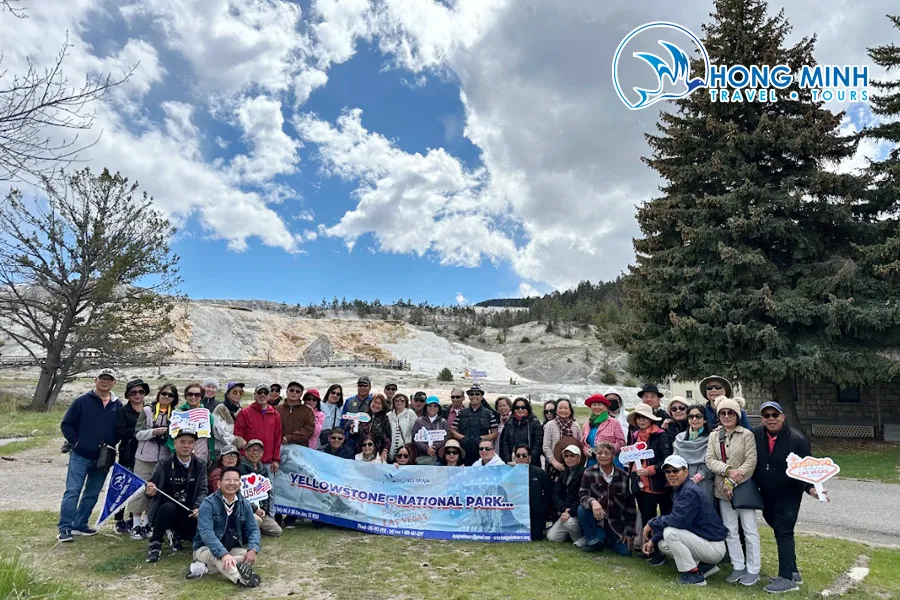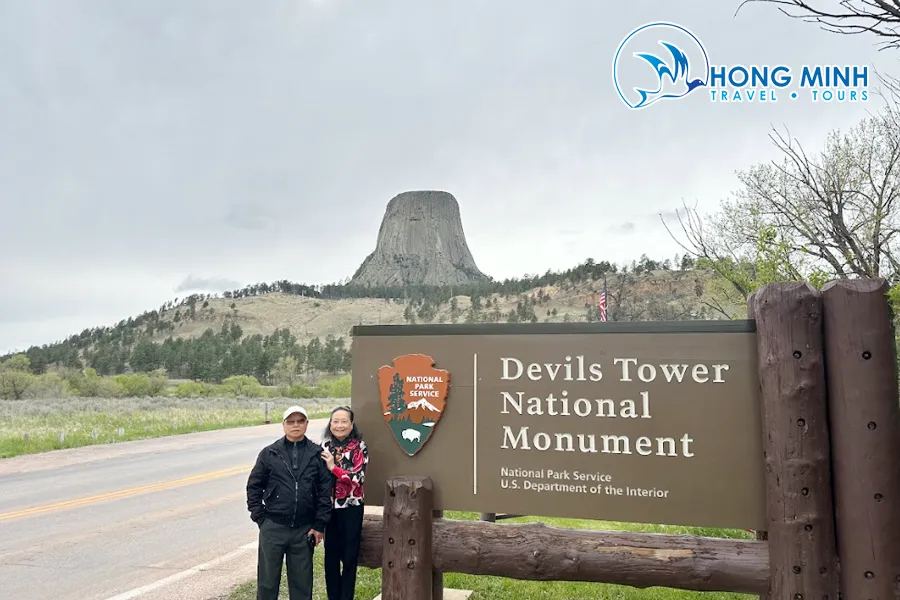Wyoming, the mountainous western state of the United States, has long been known as a wilderness paradise with a diverse and rich ecosystem. It is not only famous for the majestic Yellowstone and Grand Teton National Parks but also an ideal destination for those passionate about wildlife photography. From herds of bison leisurely grazing on vast grasslands to majestic grizzly bears foraging in deep forests, Wyoming promises unique and unforgettable photographic experiences. In this article, as a content expert from “Du lịch khắp thế gian” (Travel the Globe), I will share valuable experiences to help you “hunt” for the most impressive Wyoming wildlife photos.
Wyoming – A Promised Land for Wildlife Photographers
Wyoming boasts one of the most diverse ecosystems in North America, home to countless rare wildlife species. When mentioning Wyoming, people immediately think of Yellowstone National Park, the world’s first national park, which preserves an incredibly rich wildlife population. Here, you have the opportunity to admire and capture moments of grizzly bears, American black bears, gray wolves, pronghorn antelopes, elk, bison, and many other rare bird species.
Beyond Yellowstone, Wyoming also has Grand Teton National Park with its pristine and majestic beauty, an ideal habitat for moose, mule deer, mountain goats, and many other animals. In addition to famous national parks, Wyoming also has numerous wildlife refuges, national forests, and vast public lands, creating an ideal living environment for wildlife.
With diverse terrain ranging from high mountains, dense forests, grasslands to wetlands, Wyoming offers countless opportunities for you to explore and capture the wild beauty of nature and animals. Whether you are a professional photographer or simply a nature lover, Wyoming will certainly not disappoint you.
Top Wildlife Photography Locations in Wyoming
To have a successful wildlife photography trip in Wyoming, choosing the right location is crucial. Below are some suggestions for prominent locations that you should not miss:
Yellowstone National Park – Kingdom of Wildlife
Yellowstone National Park, with a vast area of nearly 9,000 km², is one of the largest and most diverse wildlife reserves in the world. It is known as the “kingdom of wildlife” with the presence of over 60 mammal species, over 300 bird species, and dozens of fish and reptile species.
Notable Wildlife in Yellowstone:
- Grizzly Bear: Yellowstone is one of the areas with the highest density of grizzly bears in the United States. You can spot grizzly bears everywhere in the park, especially in spring and fall when they are actively foraging to prepare for winter.
- Black Bear: Black bears are also very common in Yellowstone, often appearing in forested areas and along streams.
- Bison: The Yellowstone bison herd is one of the largest remaining wild bison herds in the world. You can easily observe them in the park’s meadows and valleys.
- Elk: Elk are the most common large mammals in Yellowstone. They often gather in large herds in winter and spring.
- Pronghorn: Pronghorn are the fastest land animals in North America. They typically inhabit grasslands and open areas.
- Gray Wolf: After being reintroduced to Yellowstone in the 1990s, gray wolves have returned as an important part of the ecosystem here. However, observing gray wolves in the wild is not easy.
Tips for Wildlife Photography in Yellowstone:
- Go Early or Late: Wildlife is most active in the early morning and late afternoon. This is the ideal time to spot them and get beautiful light for your photos.
- Use a Telephoto Lens: A telephoto lens is essential equipment for wildlife photography. Lenses with a focal length of 300mm or longer will help you capture close-up shots without disturbing the animals.
- Be Patient and Observant: Wildlife photography requires patience and good observation skills. Take time to observe your surroundings and listen to the sounds of nature to detect signs of animals.
- Safety First: Always maintain a safe distance from wildlife and follow park regulations. Do not feed animals or approach them too closely.

Yellowstone Bear World – Approaching Wildlife Up Close
If you want the opportunity to observe and photograph wildlife at a closer range, Yellowstone Bear World is an interesting option. This is a drive-through wildlife park where you can drive through large enclosures and observe animals such as grizzly bears, black bears, elk, bison, deer, and mountain goats.
Advantages of Yellowstone Bear World:
- Easy Animal Access: You can observe wildlife at very close range from your car.
- Variety of Species: Yellowstone Bear World houses many wildlife species typical of the North American region.
- Family-Friendly: This is a great destination for families with young children, helping children explore the wildlife world safely and interestingly.
Notes When Visiting Yellowstone Bear World:
- Do Not Feed Animals: Absolutely do not feed animals from your car, as this can be dangerous for both you and the animals.
- Follow Instructions: Always follow park instructions and regulations to ensure safety for yourself and the animals.
Gillette and Devil’s Tower Area – Exploring the Wild Beauty of Northeast Wyoming
The area around Gillette and Devil’s Tower in Northeast Wyoming is also an attractive destination for wildlife photography enthusiasts. Although not as famous as Yellowstone, this area still possesses a unique pristine beauty and biodiversity.
Wildlife You Might Encounter in the Gillette and Devil’s Tower Area:
- Wild Horse: Northeast Wyoming is one of the last areas in the United States where wild horse herds still exist. You can find them in public lands and vast grasslands.
- Pronghorn: Pronghorn are also very common in this area, especially in grasslands and open areas.
- Mule Deer: Mule deer are a common deer species in western North America. They typically inhabit forested and shrubby areas.
- Greater Sage-Grouse: This is an endemic bird species of the sagebrush steppe in western North America. Greater sage-grouse are threatened due to habitat loss, and Wyoming is one of the most important states for conserving this bird.
Tips for Wildlife Photography in the Gillette and Devil’s Tower Area:
- Explore Public Lands: Northeast Wyoming has many vast public lands where you can freely explore and search for wildlife.
- Learn About Habitats: Learning about the preferred habitats of each animal species will help you increase your chances of encountering them. For example, wild horses often prefer to live in vast grasslands, while mule deer often seek food and shelter in forests and shrubs.
- Use the “Spot and Stalk” Technique: The “spot and stalk” technique is an effective method for wildlife photography in a natural environment. First, you need to spot the animal’s location from a distance, then approach them slowly and carefully to avoid scaring them.

Tips and Experiences for Wildlife Photography in Wyoming
To capture stunning Wyoming wildlife photos, you need to prepare thoroughly in terms of equipment, knowledge, and skills. Here are some useful tips and experiences:
Best Time to Photograph
The best time for wildlife photography in Wyoming depends on the animal species you want to photograph and the area you want to visit. However, in general, spring and autumn are usually the ideal times.
- Spring (April – June): Spring is the breeding season for many animals. You may have the opportunity to photograph newborns and witness unique mating behaviors. The weather in spring is usually pleasant, with lush greenery and wildflowers blooming, creating a beautiful backdrop for photos.
- Autumn (September – October): Autumn is the migration season for many bird species and also the rutting season for some large mammals such as elk and mule deer. The leaves turn vibrant yellow and red, creating a wonderful background for wildlife photos.
Summer (July – August) is also an option, but the weather can be quite hot and animals are often less active in the middle of the day. Winter (November – March) can bring beautiful snow-white landscapes, but weather conditions are harsh and many areas may be closed due to snowfall.
Essential Equipment
- Camera: A DSLR or mirrorless camera with a large sensor will provide the best image quality.
- Telephoto Lens: Lenses with a focal length of 300mm or longer are necessary for photographing wildlife from a distance. Telephoto zoom lenses (e.g., 100-400mm, 200-500mm, 150-600mm) are very versatile and convenient.
- Tripod: A tripod helps stabilize your camera and lens, especially when shooting with heavy telephoto lenses and in low light conditions.
- Memory Card: A high-capacity and fast-writing speed memory card so you don’t miss any moments.
- Spare Batteries: Spare batteries are essential to ensure you don’t run out of power in the middle of shooting, especially when photographing all day long.
- Appropriate Clothing and Footwear: Choose comfortable clothing and footwear suitable for the weather and terrain conditions. Bring a warm jacket, hat, gloves, and hiking boots.
- Camera Backpack: A specialized camera backpack helps protect your equipment and carry necessary accessories.
- Binoculars: Binoculars help you observe wildlife from a distance and spot them before approaching.
Photography Skills and Techniques
- Understand Animals: Learning about the behavior, habitat, and habits of the animal species you want to photograph will help you predict their actions and capture natural and vivid photos.
- Patience and Waiting: Wildlife photography requires high patience. Sometimes you have to wait for hours to get a beautiful moment.
- Use Natural Light: Natural light is the most important element in photography. The best light usually appears in the early morning and late afternoon (golden hour).
- Composition and Angle: Pay attention to composition and shooting angle to create impressive and attractive photos. Experiment with different angles to find the best one.
- Shoot in RAW Mode: Shooting in RAW format allows you more flexibility when post-processing photos.
- Post-Processing: Post-processing helps you adjust the color, contrast, and sharpness of your photos to get the best results.
Safety During Wildlife Photography
Safety is always the top priority when wildlife photography. Here are some safety principles to follow:
- Maintain a Safe Distance: Always maintain a safe distance from wildlife. Do not approach too closely or try to feed them.
- Do Not Disturb Animals: Avoid making loud noises or taking actions that disturb animals.
- Go in Groups: If possible, go wildlife photography with others to ensure safety.
- Carry Bear Spray: If you are going into bear country, carry bear spray and know how to use it.
- Inform Someone: Before going wildlife photography, inform family or friends about your plans and expected return time.
- Learn About the Area: Learn about the area you want to visit, including terrain, weather, and potential hazards.
- Bring a Map and Compass or GPS: To avoid getting lost, bring a map, compass, or GPS device.
- Mobile Phone and Power Bank: Bring a mobile phone and power bank for communication in case of emergency.
- First Aid Kit: Bring a first aid kit to treat minor injuries.
Conclusion
Wyoming wildlife photography is a wonderful and challenging experience. With thorough preparation, knowledge, and appropriate skills, you can absolutely capture unique and impressive moments of the wildlife world in this land. Hopefully, the experiences shared in this article will help you have a successful and memorable photography trip in Wyoming. Good luck and have beautiful photos!